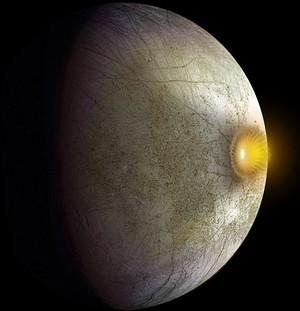Planetary securityRanking hazardous asteroid effects from least to most destructive
If an asteroid struck Earth, which of its effects—scorching heat, flying debris, towering tsunamis—would claim the most lives? A new study has the answer: violent winds and shock waves are the most dangerous effects produced by Earth-impacting asteroids. The study explored seven effects associated with asteroid impacts—heat, pressure shock waves, flying debris, tsunamis, wind blasts, seismic shaking and cratering—and estimated their lethality for varying sizes. Overall, wind blasts and shock waves were likely to claim the most casualties, with experimental scenarios showing that these two effects accounted for more than 60 percent of lives lost.

Collision of asteroid and Europa, one of Jupiter's moons // Source: commons.wikimedia.org
If an asteroid struck Earth, which of its effects—scorching heat, flying debris, towering tsunamis—would claim the most lives? A new study has the answer: violent winds and shock waves are the most dangerous effects produced by Earth-impacting asteroids.
The study explored seven effects associated with asteroid impacts—heat, pressure shock waves, flying debris, tsunamis, wind blasts, seismic shaking and cratering—and estimated their lethality for varying sizes. The researchers then ranked the effects from most to least deadly, or how many lives were lost to each effect.
Overall, wind blasts and shock waves were likely to claim the most casualties, according to the study. In experimental scenarios, these two effects accounted for more than 60 percent of lives lost. Shock waves arise from a spike in atmospheric pressure and can rupture internal organs, while wind blasts carry enough power to hurl human bodies and flatten forests.
“This is the first study that looks at all seven impact effects generated by hazardous asteroids and estimates which are, in terms of human loss, most severe,” said Clemens Rumpf, a senior research assistant at the University of Southampton in the United Kingdom, and lead author of the new study published in Geophysical Research Letters, a journal of the American Geophysical Union.
Rumpf said his findings, which he plans to present at the 2017 International Academy of Astronautics Planetary Defense Conference in Tokyo, Japan, could help hazard mitigation groups better prepare for asteroid threats because it details which impact effects are most dominant, which are less severe and where resources should be allocated.
Though studies like his are necessary to reduce harm, deadly asteroid impacts are still rare, Rumpf said. Earth is struck by an asteroid 60 meters (more than 190 feet) wide approximately once every 1500 years, whereas an asteroid 400 meters (more than 1,300 feet) across is likely to strike the planet every 100,000 years, according to Rumpf.
“The likelihood of an asteroid impact is really low,” said Rumpf. “But the consequences can be unimaginable.”
Modeling asteroid effects
AGU says that Rumpf and his colleagues used models to pepper the globe with 50,000 artificial asteroids ranging from 15 to 400 meters (49 to 1312 feet) across—the diameter range of asteroids that most frequently strike the Earth. The researchers then estimated how many lives would be lost to each of the seven effects.
Land-based impacts were, on average, an order of magnitude more dangerous than asteroids that landed in oceans.
